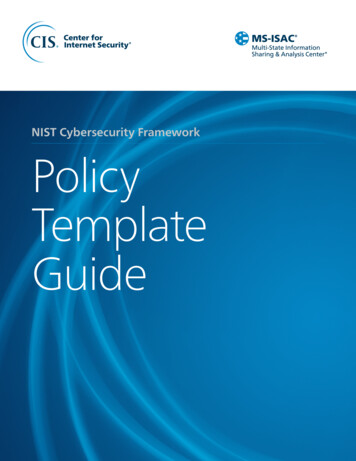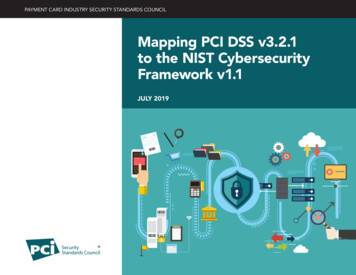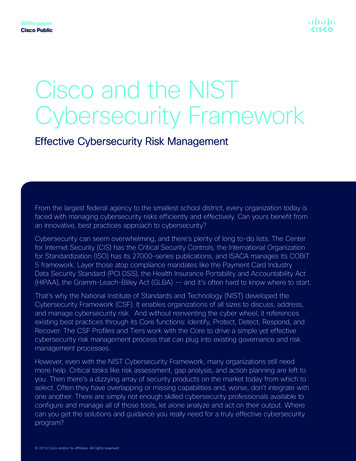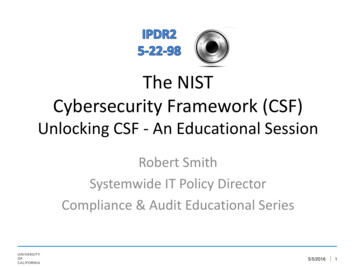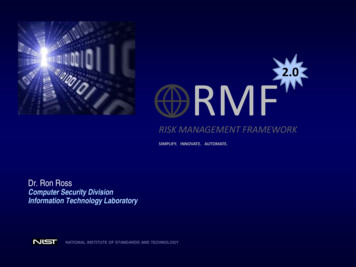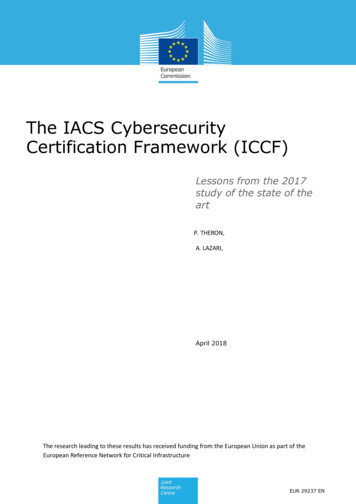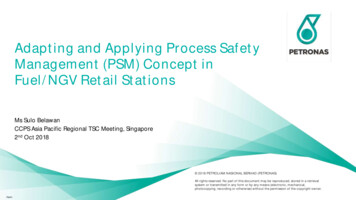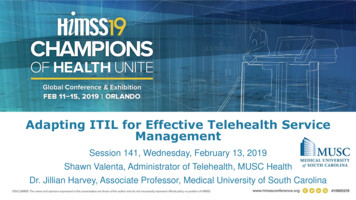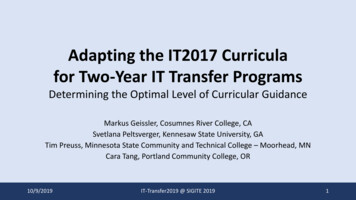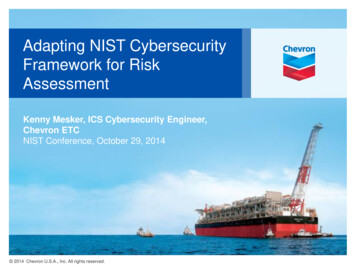
Transcription
Adapting NIST CybersecurityFramework for RiskAssessmentKenny Mesker, ICS Cybersecurity Engineer,Chevron ETCNIST Conference, October 29, 2014 2014 Chevron U.S.A., Inc. All rights reserved.
OverviewWe need: To align with industry standards To provide an efficient method of providing an ICS cybersecurity riskassessment. A scorecard to measure business unit ICS cybersecurity posture sothat our limited resources can be best focused where they are mostneeded. A common, standardized ICS cybersecurity assessment methodologythat will provide a rationalized dashboard to measure enterprise-wideICS cybersecurity posture. 2014 Chevron U.S.A., Inc. All rights reserved.2
GoalsDevelop an ICS Cybersecurity Risk Assessment methodology thatprovides the basis for enterprise-wide cybersecurity awareness andanalysis that will allow us to: Impact the business unit the least Utilize fewer resources Align with industry standards Provide a quantitative view of risk Standardize the results Align with the tools and capabilities that exist today Provide specific and actionable mitigation recommendations Show our work 2014 Chevron U.S.A., Inc. All rights reserved.3
The Two Parts to a Risk Assessment. Conformance Assessment– Determination of how “conformant” an ICS is toa set of general expectations– This is different from “compliance” Risk Analysis– The identification and prioritization of risksbased on the results of the conformanceassessment 2014 Chevron U.S.A., Inc. All rights reserved.4
Preliminary Methodology BeforeNIST Cybersecurity FrameworkFirst attempt was made in 2013 using DHS CSET Tool Provides questionnaires which align with industry standards Used 300 “basic” questions based on NIST 800 Questions are weighted, prioritized, and areas of concern aredetermined However, this is done according to a DHS internal algorithmand cannot be modified This provides a quick (though not thorough or custom)solution to the conformance problem 2014 Chevron U.S.A., Inc. All rights reserved.5
Results of Preliminary MethodologyStakeholders were pleased with structured interview styleBUT: Unable to add company-specific questions Binary answers (yes/no) to questions led to “yes bias” Results were generally useful, but lacked the granularity needed to focuson specific mitigations Results were influenced by the weighting and prioritizations that are hardcoded in the CSET tool by the DHS Outcome was good, but not greatDetermined a more customizable solution was needed 2014 Chevron U.S.A., Inc. All rights reserved.6
Framework for Improving Critical InfrastructureCybersecurity February 12, 2014, as a result of the Presidential Executive Order13636, the Framework for Improving Critical InfrastructureCybersecurity was published by NIST Not a standard, but rather an approach to describing cybersecurityexpectations Based on many standards, best practices, and guidelines Easily relatable between internal and external stakeholders The Framework is technology neutral Can be applied internationally 2014 Chevron U.S.A., Inc. All rights reserved.7
Alignment with NIST Cybersecurity Framework 22 Categories Provides common taxonomy 98 Sub-categories Alignment with industry and corporate strategyImage Source: urity-framework-021214.pdfReprinted courtesy of the National Institute of Standards and Technology, U.S. Department of Commerce.Not copyrightable in the United States. 2014 Chevron U.S.A., Inc. All rights reserved.8
Original NIST Cybersecurity a Security (PR.DS): Informationand records (data) are managedconsistent with the organization’s PR.DS-1:risk strategy to protect theData-at-rest is protectedconfidentiality, integrity, andavailability of information. 2014 Chevron U.S.A., Inc. All rights reserved.INDUSTRYSTANDARDS INALIGNMENTCCS CSC 17COBIT 5 APO01.06, BAI02.01, BAI06.01, DSS06.06ISO/IEC 27001:2013 A.9.1.1NIST SP 800-53 Rev. 4 SC-28IEC/ISA 62443-2-1:2010 4.3.2.5, 4.3.2.6, 4.3.3.3, 4.3.4.3,4.3.4.4, 4.3.4.59
Add Assessment Criteria to FrameworkFROM ORIGINAL FRAMEWORKSUBCATEGORYPR.DS-1: Data-at-rest is protectedPR.DS-1.1: Are identity and accessmanagement policies in place to protectISO 27001:2013 A.9.1.1data-at-rest?PR.DS-1.2: Has high value information been IEC 62443-2-2:4.2.3.6identified and protected?Internal StandardsPR.DS-1.3: Are processes in place to ensure NIST 800-53:SC-28that sensitive data is adequately protected Internal StandardsGENERATED ASSESSMENT QUESTIONS 2014 Chevron U.S.A., Inc. All rights reserved.SPECIFICSTANDARDS/CONTROLS(INCLUDING INTERNAL)USED TO GENERATEQUESTIONS10
The Risk Assessment Scorecard 2014 Chevron U.S.A., Inc. All rights reserved.1111
The Enterprise Risk Assessment Dashboard 2014 Chevron U.S.A., Inc. All rights reserved.1212
Risk Assessment Methodology SummaryRisk Assessment Standards (e.g. ISO27005, 31000, NIST 800-39)High Level AssessmentScored ConformanceAssessment Using ICS RiskAssessment ToolEnterprise-Wide RiskComparison and AnalysisDetailed Risk AssessmentRisk ProfilesDetailed Quantitative RiskAnalysis 2014 Chevron U.S.A., Inc. All rights reserved.1313
Questions? 2014 Chevron U.S.A., Inc. All rights reserved.
ISO 27001:2013 A.9.1.1 PR.DS-1.2: Has high value information been identified and protected? IEC 62443-2-2:4.2.3.6 Internal Standards PR.DS-1.3: Are processes in place to ensure that sensitive data is adequately protected NIST 800-53:SC-28 Internal Standards SUBCATEGORY SPECIFIC STANDARDS/CONTROLS (INCLUDING INTERNAL) USED TO GENERATE QUESTIONS
